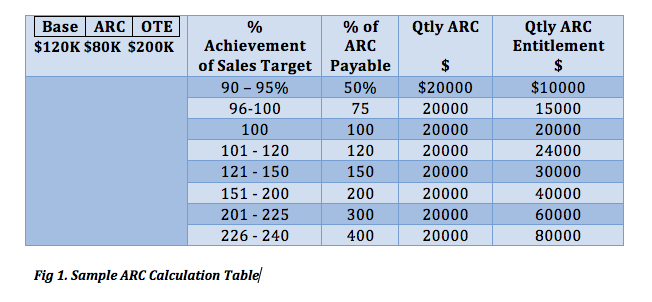|
A question we are often asked by our clients is “What should the split be between the base salary and commission for our sales people?” The answer depends on a few variables, which we will explore in this article, but before we get to that, lets start with a few definitions; On Target/On Track Earnings. (OTE). This is the salary (usually expressed as an annual figure) that a Sales person can earn if they achieve 100% of their allocated sales target/quota. It is made up of two components; A Base Salary (BS) and an At Risk Component (ARC). Base Salary (BS) As the term implies is the amount paid to a Sales person before the payment of commissions. At Risk Component (ARC) Is the “incentive” component or commission paid to the Sales person for achievement of their targets/quotas. So named as this component of the salary package is “at risk” of not being paid if the targets are not met. OTE = BS + ARC When is the ARC paid? This depends upon each organisation but usually, commissions are paid on a periodic basis (usually quarterly against quarterly sales targets) as opposed to annually. Complex sales/sales with a longer sales cycle may be paid annually. The ARC can also kick in at some point before 100% of sales targets are achieved – i.e., at 90%. Some organisations also apply an “accelerator” after the achievement of 100% of target to further incentivise behaviour. The following table provides an example.  A further consideration is whether to retain some proportion of the quarterly ARC payment to be paid at year-end. The aim of which, is to incentivise consistent performance over the year and not just in one quarter. It is common practice to retain anywhere up to 25% of the quarterly payment, which is, then payable at year-end on achievement of the individual’s annual sales target. What should the split be between Base Salary and ARC? We call this split the Pay Mix. The Pay Mix is the ratio of Base Salary to ARC. In the previous example above we have used a 60/40 split of Base Salary to ARC. Where this ratio is set depends on a number of factors including;
The nature of the sales role In the example above we used a Pay Mix of 60/40 which would be common for a front line “hunter” sales role, often more directly responsible for signing new business; Business Development Manager/Business Development Director etc. The range here could be from 50/50 to 70/30. For “farmer” sales roles, e.g. Account manager, Account Executive who may carry smaller new business targets the Mix could range from 90/10 to 70/30. For Senior Sales Manager roles, e.g. Head Of Sales, Sales Director where delivery of targets is through teams, we may expect to see the Mix around 70/30 - 80/20. For these roles the larger % Base Salary can also attract higher quality candidates. The length of the sales cycle For organisations with a shorter sales cycle, we may expect a lower Mix as deals are being closed more regularly. For longer sales cycles, a higher Mix (i.e. higher Base Salary) can help keep the motivation levels high to stay with it. The complexity of the sale For complex project/process sales the Mix again will usually be higher in order to attract a candidate with the requisite skills and industry experience. Finally, The overall OTE should be set somewhere around 1/5 of the Sales Target. In other words the Sales person should be earning the company 5 x their OTE. What are the Pros and Cons of OTE? Pros:
Considerations
If you or your team need assistance with designing your organisation’s OTE plan, the Fifth Executive team has over 50 years combined Sales experience and can assist today. Call us on (02) 9258 1130 or visit our website at www.fifthexecutive.com.au Comments are closed.
|
The FulcrumA hub for essential ideas and information, providing leverage and support to sales professionals and those that are hiring them. Archives
July 2024
Categories |
|
©
Fifth Executive
Sales Recruitment Specialists I Executive Search I Finding Top Sales Talent I Sales Recruiting by Sales Professionals.
Vertical Divider
|
Vertical Divider
|
Fifth Executive
5/20 Bond St Sydney 2000 14/333 Collins St Melbourne 3000 9/307 Queen St Brisbane 4000 Tel: 1300 33 65 74 |



 RSS Feed
RSS Feed